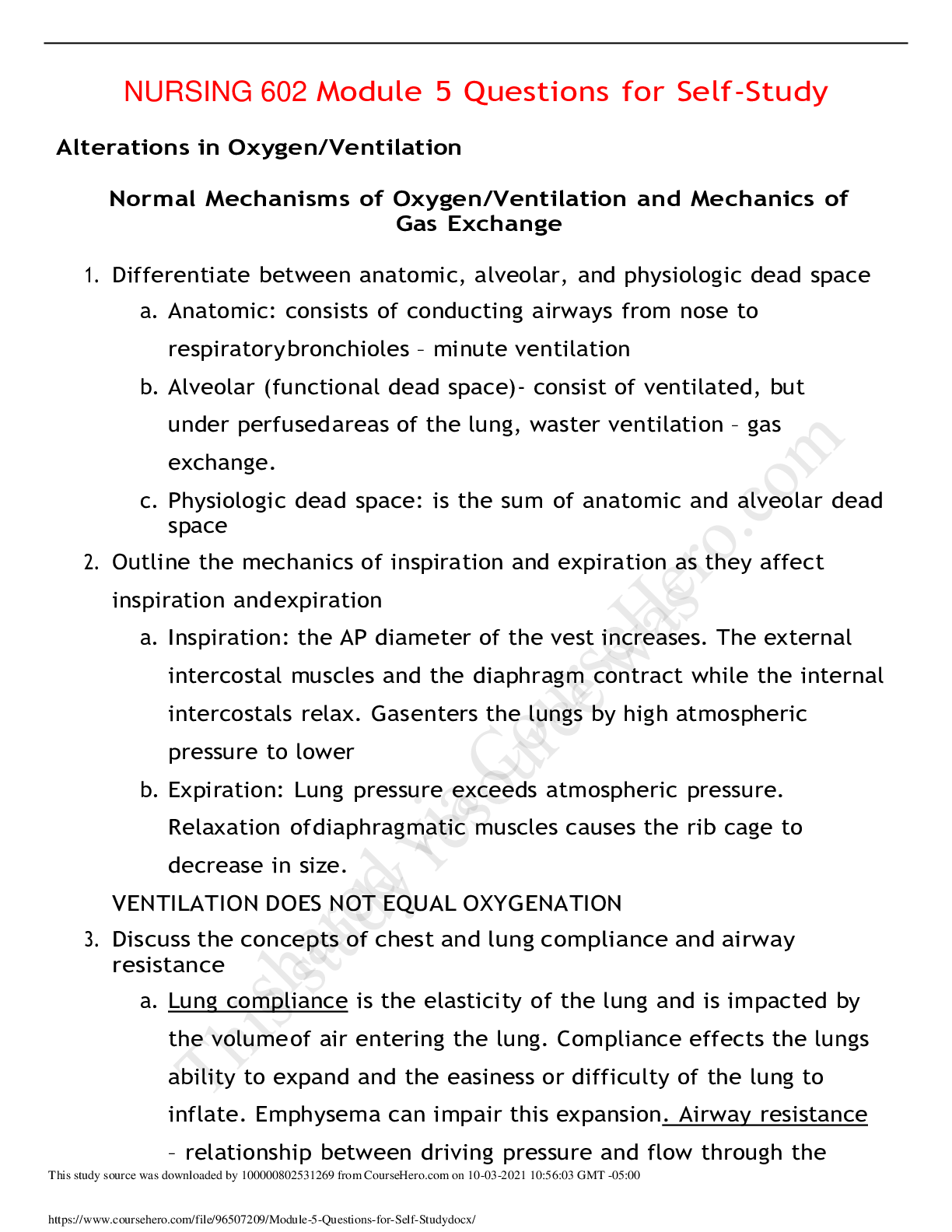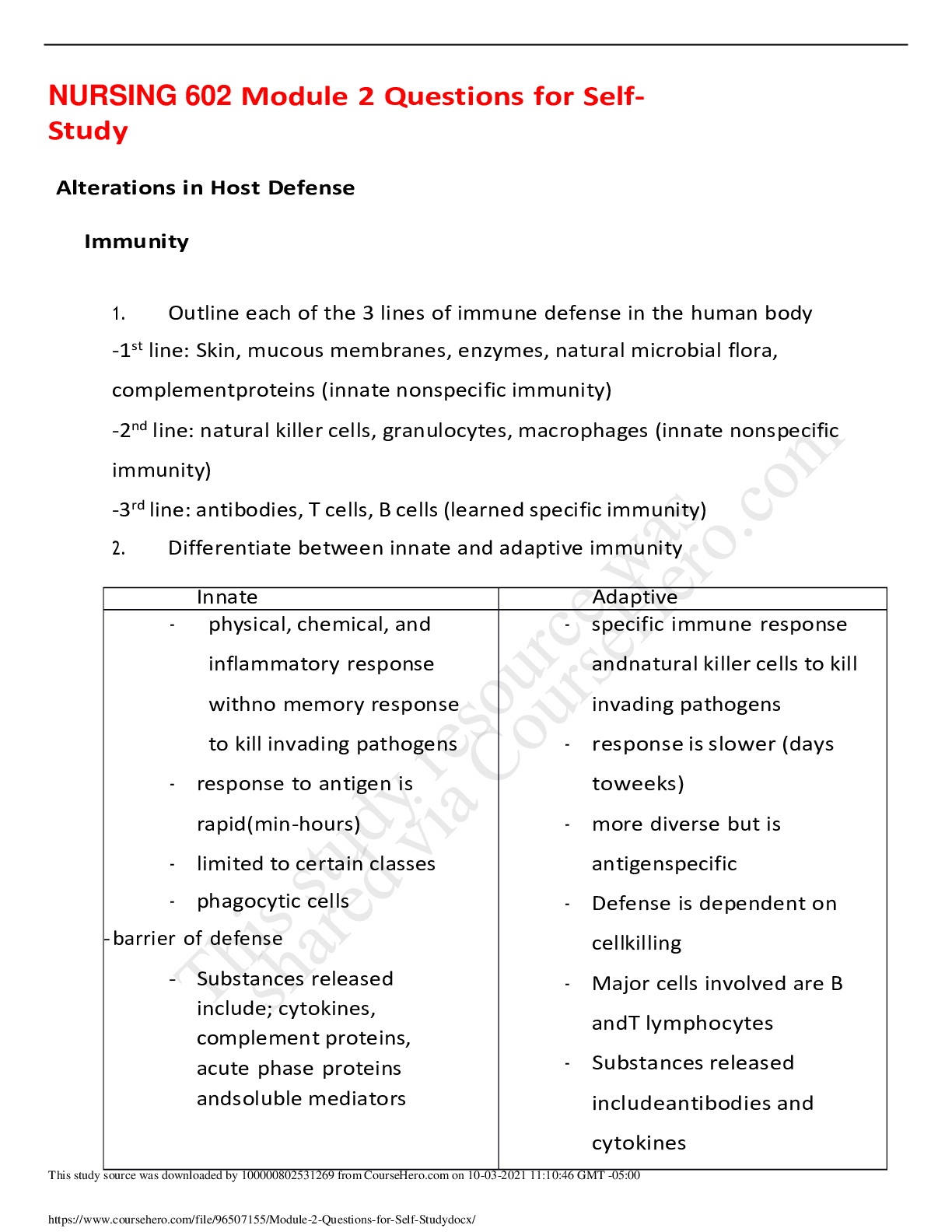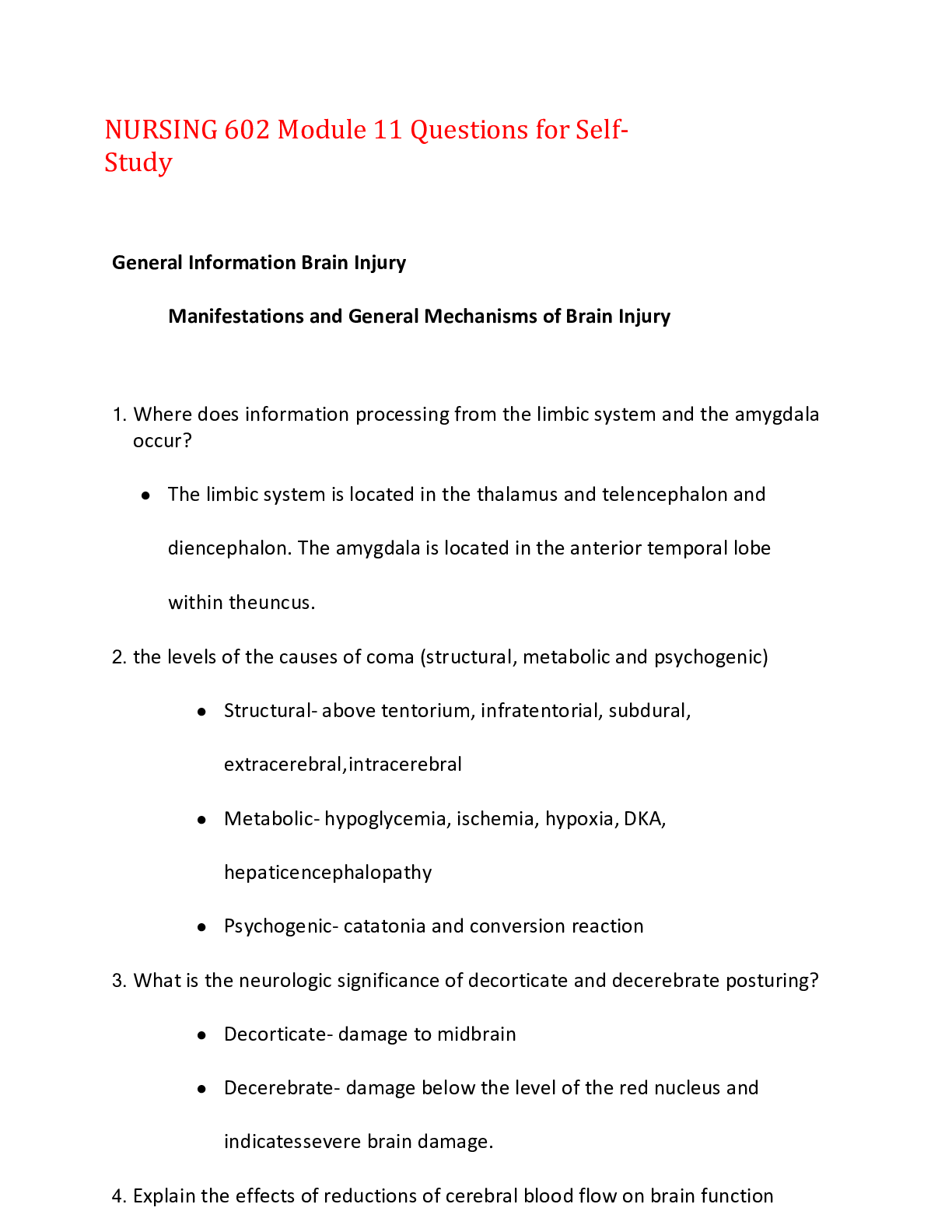NURSING 602 Module 4 Questions for Self-Study,100% CORRECT
Document Content and Description Below
NURSING 602 Module 4 Questions for Self-Study Alterations in Hemostasis/Alterations in Hematologic Cell Function Hematopoiesis and Erythrocyte Metabolism 1. Discuss the process of generation ... and destruction of red blood cells (RBC) a. Hemoglobin is made in 15 days in the bone marrow and destructed every 90- 120 days. The RBCs get trapped in the spleen and are then destroyed by macrophages, broken down into bilirubin and then pooped out. b. Vitamin b12 and folate impairment results early in RBC destruction 2. How is iron absorbed, transported and stored? a. The primary source of iron is from the diet. Iron is absorbed from the duodenum and the proximal jejunum, it is first bound to duodenum cytochrome B in the enterocyte in the intestine, iron is then bound to ferroprotein where it is transported into the blood, transferrin carries iron to the bone marrow where it can be stored as ferratin or hem for hemoglobin, excess unbound iron is stored in the liver or the spleen. b. 4 iron molecules are stored in the center of a hemoglobin. 3. Describe the erythropoietin feedback cycle a. Anemia and hypoxia stimulate erythropoietin production by kidneys to promote RBC production by bone marrow. If RBC mass is increased, erythropoietin reduces bone marrow RBC production. Coagulation and Hemostasis 1. Describe and differentiate among the stages of hemostasis a. Primary: during primary hemostasis, endothelial injury leads to exposure of the subendothelial matrix, platelet activation, and formation of platelet aggregates. The formation of a platelet plug occurs within 3-7 minutes. Thrombin generation triggers cleavage of fibrinogen and fibrin strand formation b. Secondary: consolidation of the platelet plug, counter regulatory mechanisms initiated by production of tissue plasminogen activator (t-PA) from the endothelium limits the hemostatic plug to site injury. c. Thrombus and antithrombotic events: the generation of t-PA leads to endothelial release of thrombomodulin to inhibit further coagulation. d. Coagulation factor inhibition to control coagulation: thrombin is cleaved and this precipitates plasminogen generation which results in plasmin formation, which limits clot formation. 2. Describe the elements of the coagulation cascade a. Platelets arrive to seal the wound, extrinsic and intrinsic pathway, different coagulation factors activate factor 10A, induces thrombin birth cause further activation of platelets. Fibrin is the most important constituent of the coagulation proteins. 3. Discuss the process of fibrinolysis Coagulopathies 1. What are the causes of the coagulopathies associated with DIC, hemophilia, von Willebrand’s Disease and Hepatic disease? a. DIC: Proteins that control blood clotting become overactive b. Hemophilia: caused by a lack of abnormal clothing factors VIII or IX and interferes with clot formation. X-linked disorder c. Von Willebrand’s: slowing of coagulation time and is associated with increased bleeding time. Inheritance factors of VII carrier protein d. Hepatic Disease: produces cirrhosis and leads to abnormal coagulation by impairing the absorption of vitamin K clotting factors. 2. Identify the elements and associated risk factors of Virchow’s Triad a. Endothelial injury (injury results in platelet activation), hypercoagulation, abnormal blood flow (turbulence, stasis, development of thrombi) 3. What are the risk factors associated with thrombus formation? Anemia 1. Differentiate between the causes and morphologic classifications of anemia a. Causes: reduction of raw materials- vitamin B12 deficiency, folic acid deficiency, iron deficiency. Disorders of the factory – bone marrow damage. Disorders of the finished product – RBC damage, excessive # of leukocytes, loss of blood, RBC hemolysis b. Classifications: Normocytic – normal size and shape a. Aplastic anemia b. Anemia of chronic disease c. Hemoylitic anemia d. Sickle cell disease ii. Macrocytic – MVC increased a. Folic acid deficiency b. Vitamin B 12 def c. Liver disease d. Alcohol e. Hypothyroidism iii. Microcytic – MCV decreased a. Iron deficiency anemia b. Thalassemia 2. Describe the common clinical presentations/features and compensatory mechanisms of anemias a. Related to tissue hypoxia: i. Ischemia- muscle claudication ii. Weakness and fatigue iii. Pallor iv. Increased respiratory rate and depth – external dyspnea v. CNS effects- dizziness, fainting, lethargy vi. Fatty changes in the liver b. Related to cardiovascular i. Increased heart rate ii. Increased stroke volume iii. Capillary dilation c. Related to renal i. Activation of the renin-angiotensin response ii. Increased salt and water retention iii. Increased extracellular fluid d. Related to hematologic i. Increased 2’3’ DPG in RBC’s e. Consequences of compensatory mechanisms i. Increased oxygen demands – increased myocardial oxygen consumption of the heart due to increased workload of the heart ii. Angina iii. Increased erythropoietin iv. Hyperdynamic circulation – cardiac murmurs & high output cardiac failure 3. What are the pathophysiologic causes behind the manifestations of anemia? a. Refer to question 1 4. Discuss the causes and clinical manifestations/features of vaso-occlusive crisis cell of sickle of disease a. Autosomal recessive disease caused by a single-point mutation of the beta globin china by the substitution of a valine for glutamic acid. Conditions causing deoxygenation triggers polymerization and loss of the cell viscoelastic properties. Clinical manifestations include tissue ischemia and pain, typically in the bone, spleen, chest, and brain Disorders of White Blood Cells and Lymphoid Tissue 1. Identify the conditions associated this neutrophilia and neutropenia, lymphocytosis, and lymphopenia a. Neutrophilia: bacterial infection, acute inflammation, stress due to corticosteroids, hypoxia, b. Neutropenia: overwhelming infection, sepsis, drug induced destruction c. Lymphocytosis: increase in lymphocytes. If cells are immature, this may cause acute leukemia, lymphoma, medium to large – viral infections, toxoplasmosis, small – autoimmune disease, metabolic diseases d. Lymphopenia: decrease in lymphocytes. Immunodeficiencies, toxic drugs and Cushing’s syndrome 2. Describe the pathophysiology of leukemia a. Unknown, but most cases have mutations in chromosomes. Blocking of differentiation causes the cell to be altered. 3. Outline the differences among acute and chronic leukemias a. Acute comes from immature cells b. Chronic comes from mature cells 4. Outline the manifestations, the clinical presentation, and underlying mechanisms of leukemias a. Clinical presentation includes abrupt onset, infection, bleeding, malaise, fever, lethargy, night sweats, weight loss, bone pain 5. Differentiate between the pathophysiology of non-Hodgkin and Hodgkin lymphoma a. Non-Hodgkin lymphoma- involved B-cells, T-cells, and NK cells neoplasms originating in the lymph nodes. Immune system impairment b. Hodgkin lymphoma- malignant transformation of B-cells in lymph nodes and is associated with B-cells located I the germinal centers of lymph nodes. 6. Describe the Ann Arbor staging of non-Hodgkin a. Stage 1: single lymph node region b. Stage 2: two or more lymph node regions on the same side c. Stage 3: lymph node regions above and below the diaphragm d. Stage 4: involvement of extranodal sites or several pairs of organs [Show More]
Last updated: 1 year ago
Preview 1 out of 9 pages

Buy this document to get the full access instantly
Instant Download Access after purchase
Add to cartInstant download
We Accept:

Reviews( 0 )
$13.00
Document information
Connected school, study & course
About the document
Uploaded On
Sep 30, 2021
Number of pages
9
Written in
Additional information
This document has been written for:
Uploaded
Sep 30, 2021
Downloads
0
Views
29
























